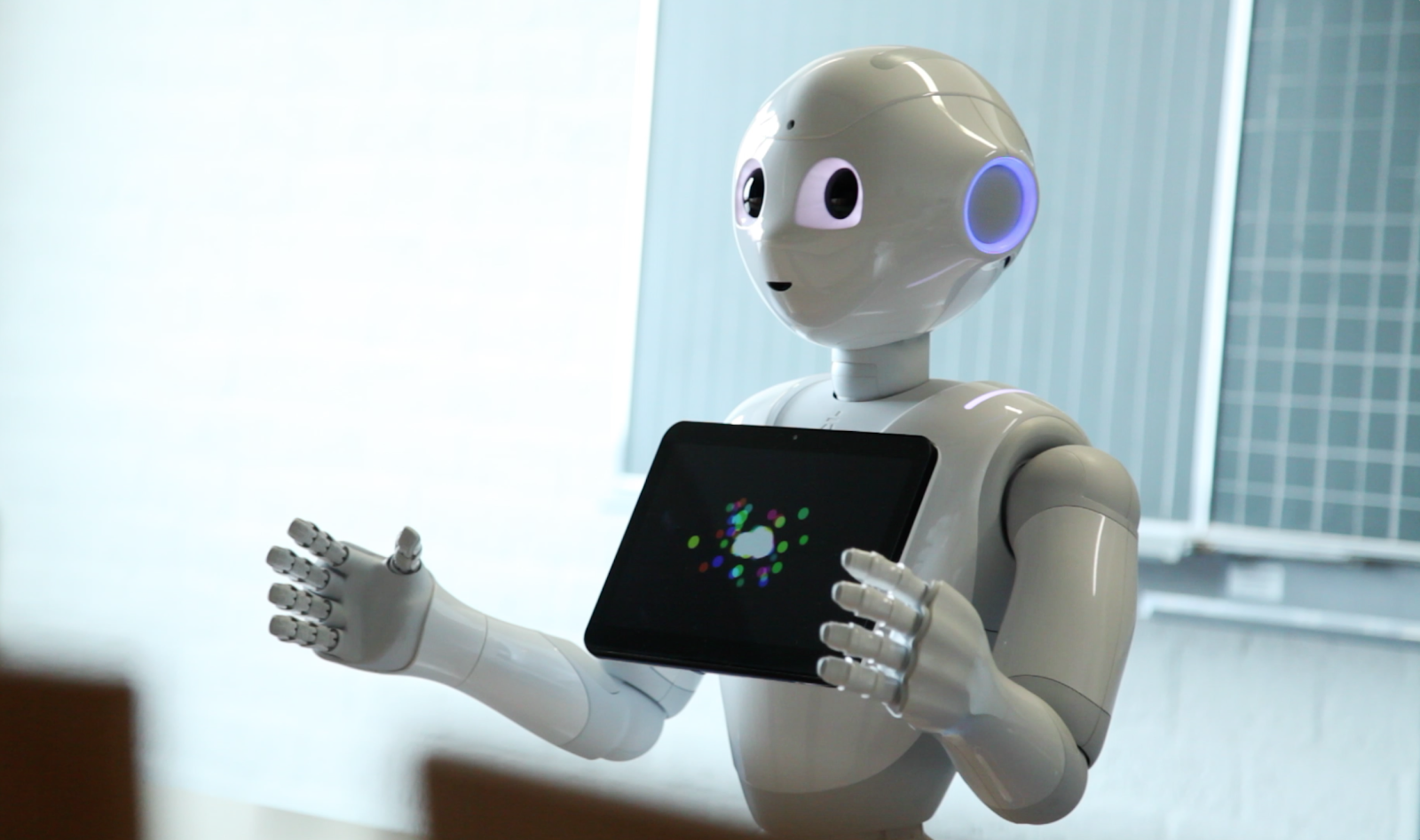VU Amsterdam - CLTL - Robot Framework
Repository for Robot Applications created as part of the Computational Lexicology & Terminology Lab (CLTL) at the Vrije Universiteit, Amsterdam.
| This is a Python 3 version of the Leolani platform and is not intended for the robot use. It does not support the NAOqi backend! It has been tested on Windows, Linux and Mac. |
|---|
Features
- A framework for creating interactive Robot Applications using Python, to enable:
- Human-Robot conversation using Speech-to-Text and Text-to-Speech
- Recognising friends by face and learning about them and the world through conversation
- Recognising and positioning the people and objects in its enviroment.
- Natural Language Understanding through Syntax Trees (Grammars)
- Knowledge Representation of all learned facts through a RDF Graph: Pepper's Brain!
- Curiosity based on Knowledge Gaps and Conflicts resulting from learned facts
- Realtime visualisation in web browser
Getting started
Check out our (old) WIKI for information on how it works.
| Part of the WIKI still references the Python 2.7 version of Leolani! |
|---|
More information
More information on the Pepper project at CLTL can be found on http://makerobotstalk.nl
Features
- A framework for creating interactive Robot Applications using Python, to enable:
- Human-Robot conversation using Speech-to-Text and Text-to-Speech
- Recognising friends by face and learning about them and the world through conversation
- Recognising and positioning the people and objects in its enviroment.
- Natural Language Understanding through Syntax Trees (Grammars)
- Knowledge Representation of all learned facts through a RDF Graph: Pepper's Brain!
- Curiosity based on Knowledge Gaps and Conflicts resulting from learned facts
- Realtime visualisation in web browser
Prerequisites
- Python 3.7.9 environment
- An application on Wolfram Alpha with for API access
- A project on the Google Cloud Platform supporting Text-To-Speech and Speech-To-Text APIs
- Docker Engine
How to start
We assume that the following steps are executed in in the directory where this README.md is located.
-
Clone this repo by running
git clone https://github.com/leolani/pepper.git -
Start from a python 3.7.9 environment (highly recommended). To create an isolated environment for the project run
python -m venv venv
source venv/bin/activateTo deactivate the environment after use type
deactivate -
Create a JSON key file for the service account used in your Google Cloud project and copy it to
config/google_cloud_key.json. -
Setup an application at WolframAlpha and create a text file named
config/credentials.configwith content:[credentials] wolfram: MY-APPLICATION-ID -
Install Java, and on Linux install portaudio by running
sudo apt-get install portaudio19-dev default-jdk -
Install the required python modules by running
pip install -r linux_requirements.txton Linux or
pip install -r mac_requirements.txton OS X or
pip install -r windows_requirements.txton Windows
-
Clone the repo pepper_tensorflow into a separate workspace by running
cd .. && git clone https://github.com/leolani/pepper_tensorflow.gitKeep in mind that this changes your current directory.
-
Build the pepper_tensorflow docker image
cd pepper_tensorflow && docker build -t cltl/pepper_tensorflow . -
Return to the root directory of this repository and download GraphDB (You have to register your email and the link will be sent to your mailbox. Check the spam folder as well. Download the standalone server version). Move the zipfile to the
setup/graphdb-docker/libfolder. In thesetup/docker-compose.ymlfile adjust the GraphDB version to the version you just downloaded.If you use a local installation of GraphDB remove the GraphDB entry from
setup/docker-compose.ymlbefore starting the Docker images in the next step. -
Run the Docker images needed by Leolani by typing
cd setup && docker-compose up && cd ..This will start:
- bamos/openface
- GraphDB
- pepper_tensorflow
Data used by these containers is stored in
setup/dataand can be reset by removing all subfolders of that directory. Depending on your Docker setup make sure the Docker containers have enough memory and CPU available. -
Make sure there is a GraphDB repository named
leolani. If not, run./setup/setup-graphdb-repo.sh.If this script fails, you may create the repository manually by accessing
http://localhost:7200/webapion your browser. UnderRepository Management, use thePOSTendpoint to upload the/setup/repo-config.ttlfile. -
The directory
pepperhas to be in the PYTHONPATH. So everytime you run an example, be sure to writePYTHONPATH="."before starting an example file.For example,
PYTHONPATH="." python apps/examples/greeting.pyIf you use an IDE to run the applications make sure that the workspace root is added to the python path, that the working directory for execution is the workspace root and not the directory containing the application script and, if a virtual environment was setup in step 1, it is used.
-
Configurations for the application are set in
config/default.configand individual items can be overriden inconfig/pepper.config. Choose the backend right backend inconfig/pepper.config(only system is supported for the Python 3 version). -
Start other applications in
pepper/apps/For example,
PYTHONPATH="." python apps/hmk.py -
Start/Stop Docker by running
cd setup && docker-compose start/stop && cd ..when stopping/restarting the application.
Usage
See How to start
Examples
See the last numbered lines in How to start
Contributing
Contributions are what make the open source community such an amazing place to be learn, inspire, and create. Any contributions you make are greatly appreciated.
- Fork the Project
- Create your Feature Branch (
git checkout -b feature/AmazingFeature) - Commit your Changes (
git commit -m 'Add some AmazingFeature') - Push to the Branch (
git push origin feature/AmazingFeature) - Open a Pull Request
